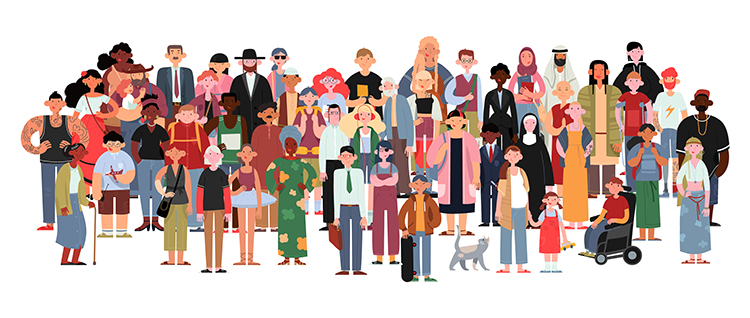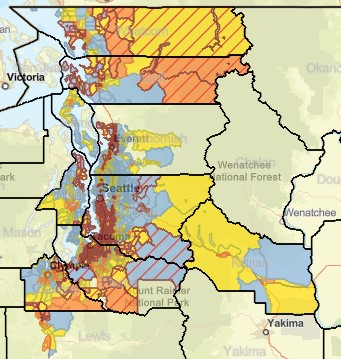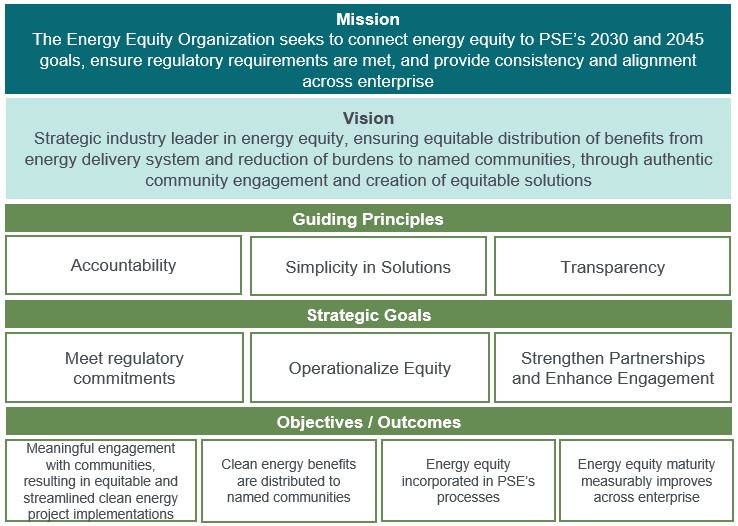A clean energy future for all

What is energy equity?
Energy Equity means ensuring that all PSE customers can access the benefits of our clean energy transition. This includes identifying inequities across our energy system, reducing barriers and burdens, and prioritizing the needs of Named Communities (including highly impacted communities and vulnerable populations) who have been historically overlooked.
Why energy equity is important
As PSE works toward the ambitious climate change goals enacted by our state’s Clean Energy Transformation Act (CETA), we must ensure that all PSE customers, especially those who shoulder an outsized share of the climate burden, have a voice in the process and can share the clean energy benefits. Energy equity is at the center of our clean energy planning, operations, and practices and is guided by:
- Clean Energy Transformation Act (CETA)
- The Climate Commitment Act (CCA)
- PSE’s Clean Energy Implementation Plan (CEIP)
- Equity-related compliance requirements in PSE’s 2022 General Rate Case (GRC)
PSE’s approach to energy equity
To guide our work, community engagement, and decision-making, we follow the four tenets of energy justice taken from the Energy Equity Project (EEP): Recognition, Procedural, Distributional, and Restorative. These nationally-recognized tenets inform the development of our Equity Guidance Tool – a series of questions that help us integrate equity practices into our work.
Recognition Justice
Requires an understanding of historic and ongoing inequalities and prescribes efforts that seek to reconcile these inequalities.
-
What we are doing

PSE created mapping tools that use factors like air pollution exposure, extreme heat, and existing social networks (such as military families or Tribes) to identify and prioritize Named Communities for clean energy investments and advancing energy equity. PSE’s Named Communities include the Highly Impacted Community and Vulnerable Populations. These maps help us with system planning and guide our community engagement efforts. See Story Map and Named Communities. Named Communities is being used as PSE’s umbrella term that includes Highly Impacted Communities and Vulnerable Populations.
Highly Impacted community means a community designated by the Washington State Department of Health based on cumulative impact analyses or a community located in census tracts that are fully or partially on tribal land.
Vulnerable Populations means communities that experience a disproportionate cumulative risk from environmental burdens due to adverse socioeconomic factors, such as unemployment, access to food and health care, etc., and sensitivity factors such as low birth weight, and higher rates of hospitalization.
-
Questions we ask
- What disparities and root factors have led to historic and current inequities? What are the deepest inequities that have been identified?
- Have we identified the communities we are helping? What are their characteristics (e.g., housing, energy burden, pollution, health, economic, etc.)?
- What other collaborative efforts are there to identify communities?
Procedural Justice
Focuses on inclusive decision-making processes and seeks to ensure that proceedings are fair, equitable, and inclusive for participants, recognizing that marginalized and vulnerable populations have been excluded from decision-making process.
-
What we are doing
The International Association for Public Participation (IAP2) spectrum defines five levels of public participation: Inform, Consult, Involve, Collaborate, and Empower. PSE has been following this spectrum as we engage with named communities and partner with customers to identify clean energy benefits.
In 2021, PSE convened an Equity Advisory Group (EAG) to help seek perspectives from, and broaden engagement with, the communities we serve. EAG members share perspectives from their lived or working experiences related to environmental justice, Tribal interests, named communities, social services, and affordable housing. PSE continues to strive to achieve the highest level of inclusivity and accessibility with the help from this group.
Highlights of EAG efforts include:
- Define named community designation for our service area
- Identify participatory barriers and burdens in clean energy programs
- Develop guiding principles for CEIP implementation
- Provide strategic input on emerging equity-related topics
-
Questions we ask
- How do we improve our engagement strategies?
- Have we engaged with the appropriate community-based organizations? Partners? Community members?
- How are we using community feedback to inform our work?
- How can we co-create programs and refine procedures with communities?
Distributional Justice
Distribution of benefits and burdens across populations. Aims to ensure marginalized and vulnerable populations do not receive an inordinate share of the burdens or are denied access to benefits.
-
What we are doing
PSE is committed to ensuring that at least 30% of clean energy benefits flow to named communities. Using the distributional equity analysis (DEA) tool, developed in partnership with the Lawrence Berkeley National Lab (LBNL). PSE aims to:
- Identify existing equity issues within the utility system
- Recommend actions for addressing inequities
- Monitor equity changes over time
- Recommend new actions as our understanding grows
-
Questions we ask
- What have we done in our processes to incorporate energy equity? What changes have been made?
- How are benefits and reduction of burdens measured?
- How are we accounting for the 30% of clean energy benefits being distributed to named communities?
Restorative Justice
Utilizes regulatory government organizations or other interventions to disrupt and address distributional, recognitional, or procedural injustices and to correct them through laws, rules, policies, orders, and practices.
-
What we are doing
PSE considers restorative justice as an integrated concept with a forward-looking approach. We will use information collected from the triumvirate of the three tenets to inform planning and adjust PSE processes to prevent future harm. We are taking a whole system approach to ensure reparative actions and subsequent strategic development will reflect the fundamental principles of restorative justice.
-
Questions we ask
- What does success look like?
- What processes may eliminate future inequities?
- Have we built a just energy system that is accessible?
Our energy equity commitments
-
Engaging with communities
Our engagement efforts focus on listening to and identifying community needs, building relationships, meeting communities and individual customers where they are at, and holding ourselves accountable with our commitments.
PSE invites community members, WUTC (Washington Utilities and Transportation Commission) staff, interested parties, CBOs (community-based organizations), and other organizations to examine our energy equity strategy. In 2023, we hosted Equity Forums in Mt. Vernon and Renton to further help us identify equity barriers and gather community insights. Future Equity Forums will allow PSE to continue to incorporate changes and refine our equity focus.









